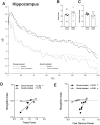Social isolation impairs the persistence of social recognition memory by disturbing the glutamatergic tonus and the olfactory bulb-dorsal hippocampus coupling
- PMID: 30679583
- PMCID: PMC6345767
- DOI: 10.1038/s41598-018-36871-6
Social isolation impairs the persistence of social recognition memory by disturbing the glutamatergic tonus and the olfactory bulb-dorsal hippocampus coupling
Abstract
The absence of companion may jeopardize mental health in social animals. Here, we tested the hypothesis that social isolation impairs social recognition memory by altering the excitability and the dialog between the olfactory bulb (OB) and the dorsal hippocampus (dHIP). Adult male Swiss mice were kept grouped (GH) or isolated (SI) for 7 days. Social memory (LTM) was evaluated using social recognition test. SI increased glutamate release in the OB, while decreased in the dHIP. Blocking AMPA and NMDA receptors into the OB or activating AMPA into the dHIP rescued LTM in SI mice, suggesting a cause-effect relationship between glutamate levels and LTM impairment. Additionally, during memory retrieval, phase-amplitude coupling between OB and dHIP decreased in SI mice. Our results indicate that SI impaired the glutamatergic signaling and the normal communication between OB and HIP, compromising the persistence of social memory.
Conflict of interest statement
The authors declare no competing interests.
Figures







References
Publication types
MeSH terms
Substances
LinkOut - more resources
Full Text Sources
Medical
Miscellaneous

